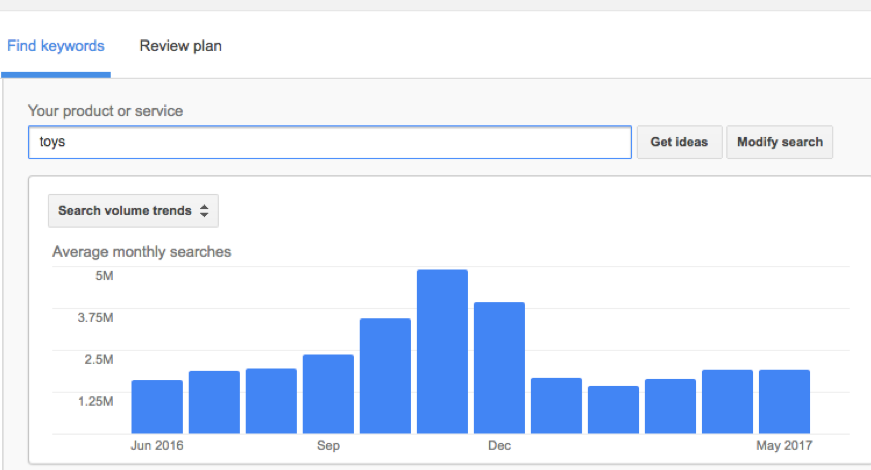With online retail sales forecast to grow 11% this year (The IMRG Capgemini eRetail Sales Index, 2017), look ahead to the seasons this year and plan your Pay Per Click (PPC) strategy throughout the year to make best use of the influx in spending in the festive season, the summer holidays, and everything in-between.
Here are some top tips to use Seasonal PPC to drive traffic to your website, alongside the risks and benefits:
Timing is Key:
Make sure your ads are running at the most relevant times, and make sure your adverts are ready to go for Black Friday, Christmas, Boxing Day etc. Below are some of the top peak seasons in e-commerce – But remember to take into consideration the time it takes to research and plan for each stage of the buying process.

Continue to test:
Traditionally, E-commerce has always been the field where A/B testing takes place, as you can take advantage of the controlled online environment (Koukouvis, 2016). Creating variations and tweaking all help to see which advert works better and what people tend to prefer. Continual testing will mean you are able to improve your performance based on consumer habits and current trends.
If you want to A/B Test to an exact degree when considering the click through rate for your campaigns, we recommend using Fisher’s exact test (1956, cited in Koukouvis, 2016). The idea is to find whether two classifications are associated.
Using Fisher’s hypothesis, you too can test the higher click-through-rate within two campaigns. For example, comparing ‘New York Budget Hotel’ or ‘New York Budget Hotel – Best NY Hotel Rates in Seconds’ and comparing the click through rates to see if the different between A and B means more clicks.
Don’t be Afraid to Increase your Budget:

Even if you have been ranking highly throughout the year for your campaign, remember that your competitors may also rank up their spending over the Christmas period (Search Engine Journal, 2017). Make sure you have your budget allocated for your Christmas Adwords campaign in the final quarter to make the most of it.
The below screenshot exemplifies how the time of the year can affect search terms, showing a jump of 3x as many searchers in November in comparison to February.

Other examples include Black Friday with an increase in Google searches of about 1.8x, and 8x for swimsuits when comparing September to January with February to August (Search Engine Journal, 2017).
Use Google Shopping:

If you haven’t set one up yet, it may be a little tricky to set up a shopping campaign at first, but it is likely to help boost traffic to your website.
Google Shopping Ads gives you more scope than the normal Google text based ad, as you can show users a photo of your product, and add a title, store name, and more. You can promote your online and local inventory, and ultimately boost traffic to your website (Google, 2017, Broos and Ramos, 2017). If you already have Google Shopping as part of your PPC strategy, make sure you are getting the most out of shopping retargeting this year!
Create Countdown Ads:
Countdown ads are a great way to countdown the number of days in your ad (McCormick, 2017). For example, it is likely if you are an e-commerce retailer that you will have a last postage date for packages to arrive before Christmas. Thus adding a countdown to your ads, such as ‘Order Within 3 Days To Get Delivery Before Xmas’ creates an invaluable call-to-action without spending any more on your ad.
So how does it work? Countdown ads play on ‘Urgency Psychology’ (Anestis, 2009) which helps to create a sense of urgency, causing the user to suspend deliberate thought, and to act quickly.
Split your successful campaigns into mobile:

Consider looking at your highest-revenue driving campaigns and putting them into their own mobile campaigns. Splitting a campaign helps focus on the campaign and set the campaigns up for success.
And with mobile web usage overtaking desktop for the first time (The Telegraph, 2016) this means you can make the most of your successful campaigns and keep ahead of changing consumer trends.
Don’t Forget About Social Media:
Make sure to use the right social media platforms and use paid adverts this Christmas as part of your seasonal PPC strategy.
Creating ads, boosting, and sponsoring on your chosen channel will make sure you are incorporating festive and engaging images and videos into your campaign. And it’s in the stats, too: According to Zenith (2016) Facebook and Google take up 20% of Global Spend, meaning it’s probably best to incorporate different media advertising for a multi-media marketing campaign package.
However, remember that managing many social media channels successfully requires strong strategy and data analytics (King, 2017) where the underlying goal of social media efforts is making sure data is collected. This data can then be used to form your strategy. For example, Facebook has hundreds of variables to target the right consumer, and gives you the level of insight needed to make sure you are targeting the right kind of customer, and reducing wastage in your time and resources.
Deck out your landing pages:
Of course, make sure your landing pages are in line with your Google Ads to minimise the bounce rate and increase the conversion rate.
Look at your analytics to see how well your landing page is performing, and look at your KPIs to benchmark yourself. Using a data-drive approach, Plaza et al., (2011) suggests using e-metrics such as Google Analytics, and gives the following KPIs to measure website effectiveness, namely: hit rate, pages per visit, length per visit, pages per visit, bounce rate, and return rate.
Ensuring your website has great website design can also help boost your conversion rate too. Fogg et. al (2003) asked students to rate suppliers on the term ‘credibility’ based on the design of the website. Amongst others, the term design look was factored at 46.1% in importance and information design/structure was rated at 28.5% – the top two factors for credibility.
And to further back this up, Dickinger and Stangl (p.771, 2013) states that website design design is “a key driver of performance perception…dealing with the site’s visual appearance such as colour, text presentation, pictures, videos, and sound”- So make sure to offer great website design to make optimum use of those that do click!
The Benefits:
One of the great benefits of PPC is that it’s highly customisable, allowing you to make changes whenever necessary. (McCormick, 2017). By making the most of your seasonal PPC and making the most of the increase in consumer spending, the benefits can be tenfold: leading to more traffic to your website – and if the website UX is right – ultimately leading to more conversions and more sales.
The Risks:
As we mentioned before, the PPC model works on driving traffic to your website, and payment is made on each click through to your website, and not the subsequent conversion (McCormick, 2017). Subsequently, paying for each click doesn’t necessary mean more sales, so PPC can be get very expensive if the ads are not optimised properly, or you get your negative keywords wrong for example (McCormick, 2017). Thus, as an online retailer, your aim is to find an optimal dynamic advertising policy, to maximise your total revenue (Chen et al., 2007).
There can also be some skepticism surrounding ads. Some people ignore sponsored ads as a rule, meaning there will always be a percentage of the population who will never click (Chen et al., 2007).
Automation: Your Best Friend?
If you’re the main account manager and plan to take a well-deserved Christmas break, remember AdWords rules on automation! However remember campaign budgets are often left on high budgets to maximise impression share over the crucial Christmas period, with teams forgetting to decrease their budgets before the new months starts, often meaning a large proportion of next month’s budget is spent in the first few days of January. New Years is a prime example of this (Search Engine Journal, 2017).
Finally, here are some last minute Christmas PPC Tips to keep you busy.
Happy PPC-ing everyone!
References:
Broos, S. & Ramos, J.M. 2017, “Competing Business Models and Two-Sidedness: An Application to the Google Shopping Case”, The Antitrust Bulletin, vol. 62, no. 2, pp. 382-399.
Chen, F.Y., Chen, J. & Xiao, Y. 2007, “Optimal Control of Selling Channels for an Online Retailer with Cost‐per‐Click Payments and Seasonal Products”, Production and Operations Management, vol. 16, no. 3, pp. 292-305.
Fisher, Sir Ronald A. (1956) [The Design of Experiments (1935)]. “Mathematics of a Lady Tasting Tea”. In James Roy Newman. The World of Mathematics, volume 3 Courier Dover Publications.
J, Atenis. (2009) All emotions are equal the difference is between the positive and negative urgency [online] Available at: http://www.psychotherapybrownbag.com/psychotherapy_brown_bag_a/2009/05/not-allemotions-are-created-equal-the-difference-between-positive-and-negative-urgency.html [Accessed 5 Jan. 2018]
King, W. 2016, “Managing Multiple Social Media Channels Requires Strong Strategy, Data Analytics; Learn how a variety of credit unions are working to get the most digital branding benefits – and valuable intelligence about their members – from being on Facebook, Twitter and LinkedIn”, Credit Union Journal, vol. 20, no. 15, pp. 11.
Koukouvis, R. A., Cubero, R.A., P. Pelliccione, (2016) Chalmers University of Technology, IT Faculty, University of Gothenburg, Department of Computer Science and Engineering (Chalmers).
McCormick, K. (2017). What is Paid Search Advertising and Why Use It? | ThriveHive. [online] ThriveHive. Available at: https://thrivehive.com/paid-search-advertising-use/ [Accessed 6 Jan. 2018].
R, Duffett. (2015) “Facebook advertising’s influence on intention-to-purchase and purchase amongst Millennials”, Internet Research, Vol. 25 Issue: 4, pp.498-526,
Searchenginejournal.com. (2017). Seasonal PPC Tactics [online] Available at: https://www.searchenginejournal.com/seasonal-ppc-tactics/199744/ [Accessed 5 Jan. 2018].
Titcomb, J. (2016). Mobile web usage overtakes desktop for first time. [online] The Telegraph. Available at: http://www.telegraph.co.uk/technology/2016/11/01/mobile-web-usage-overtakes-desktop-for-first-time/ [Accessed 5 Jan. 2018].
Waisberg, D. 2015, Google analytics integrations, Wiley-Blackwell, Indianapolis.
YouTube. (2018). Last Minute Christmas PPC Tips. [online] Available at: https://www.youtube.com/watch?v=TQJ9O9hlpnw [Accessed 6 Jan. 2018].






